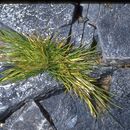en
names in breadcrumbs


Deschampsia antarctica, known as the Antarctic hair grass, is one of only two species of flowering plants native to Antarctica (Rosa et al., 2009). D. antarctica can be found mostly around maritime Antarctica and coastal areas specifically: the South Orkney Islands, South Shetland Islands, and along the western Antarctica Peninsula (Vera et al., 2012). D. antarctica is part of the Poaceae family and Deschampsia genus that consists of annual and perennial grasses that flourish in a wide array of temperatures including polar regions of the world (Cardone et al., 2009). Antarctic hair grass is composed of thick tissues that are favorable in frigid environments and low-nutrient soils common in Antarctica (Parnikoza, 2007). Distribution of the Antarctic hair grass depends on environmental conditions concerning: soil fertility, water availability, and the presence of animal colonies (Nedzarek and Chwedorzewska, 2004). D. antarctica can grow in clusters that can cover several hundred square meters and/or alternatively (at higher elevations) Antarctic hair grass can be scattered around large areas of terrestrial space (Chwedorzewska et al., 2008). Antarctic hair grass is abundant near penguin rookeries and gathering places of large mammals, acquiring nutrition from excremental waste (Chwedorzewska et al., 2008). In ideal conditions characteristics of the Antarctic hair grass individuals are observed to have: a dark green color, robust, erect culms (stems), and well-developed foliage (Chwedorzewska et al., 2008). In harsher areas of the Antarctica tundra, individuals are much smaller in size, have an olive-green color and form small, single, flat tufts (Chwedorzewska, 2008). Antarctic hair grass produce flowers that seed and seed dispersal is facilitated by birds (carried in the digestive tract of gulls and skuas), although clonal growth towards the expansion of the Antarctic hair grass has been observed in less harsh areas (Convey, 1996).
D. antarctica has a diploid number of 26 chromosomes in its genome which allows the grass to perform metabolic processes at very low temperatures (Xiong et al., 1999). The Antarctic hair grass ability to flourish in such extreme conditions has reinforced genetical breakthroughs pertaining to freezing-tolerant enhanced vascular plants (John and Spangenberg, 2005). Knowledge gained regarding freeze tolerance from further genetical research of the Antarctic hair grass species could be used in agricultural science concerning crop resistance against frosts (John and Spangenberg, 2005). Antarctic hair grass populations have also been migrating to non-native portions of maritime Antarctica due to the climatic change occurring from global warming (Convey and Smith, 2006). The sudden influx of water (from ice/snow melt) and rising temperatures are making these once unsuitable areas, suitable for Antarctic hair grass populations to inhabit areas outside their native boundaries (Convey and Smith, 2006). The arrival of founder individuals on new areas could heavily impact the biogeochemical cycles (ecological balance) of each area the grass is introduced, through mass extraction of primary nutrients taken up from the newly formed hair grass populations (Convey and Smith, 2006). The overall ecological impaction of migrant hair grass has not been studied and the hair grass effects on biogeochemical pathways are still unknown (Convey and Smith, 2006). Accidental introduction of non-native species of flowering plants to Antarctica through anthropogenic activities has added competiveness between D. antarctica and these newly-introduced invasive species (Convey, 2011). Conservation techniques have been carried-out to further prevent the traveling of non-native species of plants in support of preliminary action towards endangerment (out-competiveness) of D. antarctica (Convey, 2011).
Deschampsia antarctica, the Antarctic hair grass, is one of two flowering plants native to Antarctica, the other being Colobanthus quitensis (Antarctic pearlwort).
They mainly occur on the South Orkney Islands, the South Shetland Islands, and along the western Antarctic Peninsula. A recent warming trend has increased germination, and thus number of seedlings and plants, also extending their range southward to cover larger areas; reports indicate a twenty-fivefold increase in their number.[2]
Deschampsia antarctica has been recorded by the Guinness Book of World Records as the southernmost flowering plant. In 1981, a specimen was found on the Antarctic Peninsula's Refuge Islands at a latitude of 68°21′S.[3][4]
Since 2009, both D. antarctica and C. quitensis have been spreading rapidly, which studies suggest has been the result of rising air temperatures and a reduction in the number of fur seals.[5]
Deschampsia antarctica, the Antarctic hair grass, is one of two flowering plants native to Antarctica, the other being Colobanthus quitensis (Antarctic pearlwort).
They mainly occur on the South Orkney Islands, the South Shetland Islands, and along the western Antarctic Peninsula. A recent warming trend has increased germination, and thus number of seedlings and plants, also extending their range southward to cover larger areas; reports indicate a twenty-fivefold increase in their number.
Deschampsia antarctica has been recorded by the Guinness Book of World Records as the southernmost flowering plant. In 1981, a specimen was found on the Antarctic Peninsula's Refuge Islands at a latitude of 68°21′S.
Since 2009, both D. antarctica and C. quitensis have been spreading rapidly, which studies suggest has been the result of rising air temperatures and a reduction in the number of fur seals.